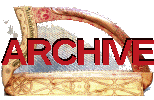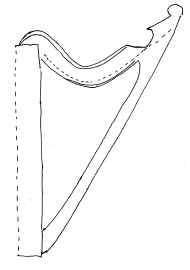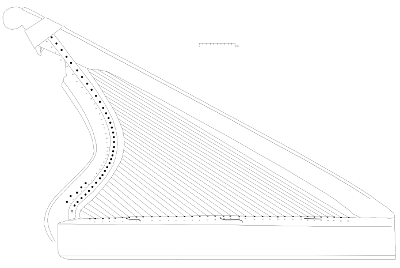

|

Dated to the 18th Century
Also known as the Carolan harp or the Clonalis harp
Kept on display at Clonalis house, Ireland, ancestral home of the O’Conor family.
35 strings (perhaps originally 36)
"High Headed" design;
longest string approx. 99cm

This harp is traditionally said to have belonged to Turlough O'Carolan (1670 - 1738). It is not well studied; it is not listed in either of the two main authorities, R.B. Armstrong (1904) or Joan Rimmer (1969).
There are two slightly different accounts of the provenance of this harp. One says that when Carolan died, he bequeathed it to Madam MacDermott-Roe, at Alderford, and it was subsequently transferred to the O'Conors of Belnagare (the ancestors of the O'Conors of Clonalis). The other account says that Carolan bequeathed it to Denis O'Conor of Belnagare. Denis O'Conor's son, Charles O'Conor, was a friend and harp student of Carolan. (see my article, ‘Provenance and recording of an eighteenth-century harp’ The Galpin Society Journal LXXIII, March 2020, p92 for references)
There are at least three harps associated with Carolan: this one owned by the O'Donnor-Nash family, and preserved at Clonalis; the NMI Carolan harp, owned by the National Museum of Ireland and preserved at Collins Barracks; and one that was said to have been at Alderford, which is said to have been burned in a fire at Alderford House. The harp shown in Carolan’s portrait may be the destroyed Alderford harp, or may be a 4th different harp. See my article on the NMI Carolan harp for full discussion and references: Simon Chadwick, ‘Provenance and recording of an eighteenth-century harp’ The Galpin Society Journal LXXIII, March 2020, p.85-110 & 199-201.
According to Pyers O’Connor Nash, owner of Clonalis house, the harp is made largely of sycamore. From visual inspection, the constructed soundbox and the neck could be sycamore, though it could equally be a softer wood such as willow or alder; the composite forepillar is a different wood, with a close tight straight grain, and may be a later replacement.
The harp is made of a number of different pieces of wood, nailed and glued together. The soundbox is made from a curved front, two sides, and two end blocks. The bass end block has two holes presumably for inserted legs; there is no projecting foot. The neck is one piece, with heavy brass cheek bands. The bands seem to have more holes than there are in the wood, so it is hard to know exacly how many strings it had. It looks like the very highest hole is unused, giving a total of 35 strings, However a few of the bass positions may also be blocked, and there may be a 36th pin hole concealed under the iron repair plate in the bass. The forepillar is made of a main part, and a seperate T-section front nailed on. The scroll is a crude plain disc. There is severe woodworm damage to the bass end block, and to the neck-pillar joint, with considerable loss of wood there. A metal repair strap around the top of the forepillar conceals the bass ends of the cheek bands, but does not seem very effective in repairing the damaged joint.
The tuning pins are brass, in nice decorated 17th century style, but are all different lengths and designs, and a number are missing, Three have string fragments of brass wire preserved wrapped round their ends.
There is evidence of rather crude re-working of the harp. There are five tuning pin holes in the treble, bored through the neck above the metal cheek band. I imagine the wood inside the neck has split here, stopping the top five pins from holding tight in their holes. There is also a second row of string holes in the soundboard, starting in the middle of the harp and diverging to the left towards the treble. Perhaps these are to try and straighten up the plane of the strings. The shoes or the central strip is missing so it is hard to see what these two runs of string holes represent.
This harp was taken to New York in April 1886, where it was exhibited by the Gaelic Society there. According to newspaper reports, the harp was re-strung, and was played upon by Miss Inez Kinsale who sung and played on it "The Coulin". It is not clear if the reports or restringing are true or not; there was concern in the mid 19th century about its condition and it was placed in a glass case to preserve it then. For that trip, the harp was valued at $10000 (£2074) and insured for $5000 (£1037). New York Times, April 26, 1886
My drawing below is based on a photograph taken with rulers placed against the case, to try and get some dimensional information about the harp. I would guess that the drawing is accurate to a few percent, not very good but better than nothing. Eventually it would be good to get a laser-scan of this harp, as we have done with some of the other harps in the National Museum of Ireland.

click to see a large version of this image scaled at 5px/mm
I have also made a speculative string chart based on the measurements from this drawing, showing the harp with 35 strings, from bass GG up to treble g''', and with five strings below cronan G. Click here for PDF string chart. The chart also includes a chart for 36 strings, with the inclusion of a speculative 36th pin that may be concealed behind the iron band in the bass.
Simon Chadwick